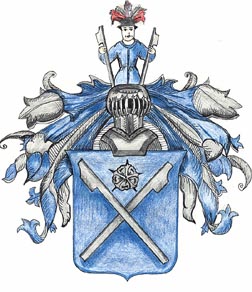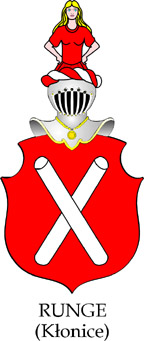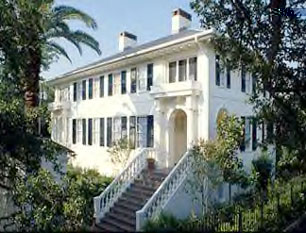

The Origins of the Surname Rünge

The Meaning of the Name Rünge:
Rünge/Runge is listed as meaning - "descendant of Runico" in Elsdon C. Smith's New Dictionary of American Family Names. New York: Gramercy Publishing Company, 1988. In my German dictionary Runge is said to mean: "upright." The word Rüge has an archaic meaning of some sort of punishment. No comparable word exists in Polish.
Ruge also is listed in the Zeidler book online. This can be accessed at Generic Book Query Form
In English, we use the word "rung," meaning a piece in something framed or constructed (as the rung or rail on the side of a cart) or the rungs or spokes of a wheel. The etomology of the word rung, shows us that it originated in Germany, the Danish made it "rong", and the Anglo-Saxons made it "hrung," before it became "rung" in English.

Riestap states:
Rünge/Runge is derived from the German word "runge" referring to "a stake," in particular the type of stake which forms a support on the side of a wagon. Thus one so named would have been a cartwright.
Runge II:
In early records, a Volkuring Runge is found in Rostock in 1280. In 1283, a Hartmundus dictus (called) Runge was found in Osterspai, Rheingau, Germany.
*The Runge II coat of arms is the one that was used by the Runge-Sypniewski family, before they took up the Odrowaz clan arms. In Emilian Zernicki's Die Polnischen Stammwappen(Polish Family Coat of Arms), printed in 1904; in the chapter "From the Province of Prussia since 1466," (page 121), it states that the arms has upright crossed silver proper (wheel rungs or braces) over which there is a red rose. The helmet shows a little man dressed in blue and standing upright holding the same "crossed upright" braces. The little man is wearing a black hat with six feathers. The book also identifies this as being the arms used by a branch called Sypniewski. This would be Jacob Runge-Sypniewski as stated in the Sypniewski part of the Golden Book of Polish Nobility. This Runge II arms originated in Prussia, Pomerania; around 1467. Runge was originally known as Rungen (*see below) The Runge II obviously relates to the Rungen coat of arms below. I found a Johann Heinrich von Rungen, a noble, whose descendants were recorded in both 1596 and 1797 in Estonia on Saaremaas [see box].
Runge II Arms: On a blue shield, two stakes (dwang braces/building struts) crossed colored silver for Rungen, and the upper half with one silver rose: the crest ornament is a guardsman dressed in blue. The 2nd variation of Rungen (Runge II) is similar to the first, except the guardsment has a black hat, and six ostrich plumes (as shown above), while the rose is red rather than silver. This coat of arms was originally for both Sypniewski and Dzwiezgowski (from the line of Marcin Sypniewski who owned an estate called Dzwiergowski in the district of Zloczowski) who were said to have separated from this branch, according to Winckler, Siebmacher, Schmitt, and Flatow. (Reference: Winkler: Siebmacher: Schmitt (from Der Polishche Adel, Volume II, 298).
Rungen Arms:
|
Rungen [original spelling of Runge] - Island d'Oesel [the German name for Saaremas Island, in the Baltic Sea (1764) on a blue shield is a rod of argent (silver) with braces upon the shafts of the same, crossed in saltire (aac.) in chief; a rose de gules (red) without stem or foliage. Saaremas Island is now part of Estonia
CREST:
A man standing with only the forepart visible, in a coat of sable (black), on his head he is wearing a matching hat, and a belt of argent (silver) with a band of the same. This man is holding in each hand a rod, edgewise.[Rietstap, J.B. Armorial General tom 1: Diuexieme Edition, refondue er augmentee (published) Gouda: G. B. Van Goor Zoon, 1884].
***The section (above) was translated from French to English by Margaret Odrowaz-Sypniewski
Saaremas is a 90 mile long island in the arm of the Baltic Sea, at the mouth of the Gulf of Riga, belonging to and west of Estonia. The island is 1048 square miles. It is between Latvia and Estonia. Riga is a seaport in and the capital of Latvia, on the Gulf of Riga. Towns and features: Undva nina, Orissaare, Kuresaare, and Saare. (Webster's Unabridged Dictionary). |
A special thanks to Leonard J. Suligowski [former Heraldry Director of the Polish Nobility Association for locating the Runge II arms for me, and for his translating same from Polish to English.
Other Runge Arms:
A Rünge family from Guben was granted a coat of arms.
Description: Blazon-per fess; first argent, the bust of a unicorn proper, issuing from the partition; second gules. Their crest: between two buffalo/bison horns argent and gules, the unicorn of the arms issuant.
Another Runge shield is a red shield with a gold stripe and their crest is buffalo/bison horns. Another variation of this has a small bundle of gold. Crest: two buffalo horns of gold. This arms is from the province of Bremen, according to Rietstap.
Yet another Runge arms is from Pomerania: Shield of gules (red) two rods (rungs) of argent (silver), charged of three violins of or (gold) laying in pale, the handle at the bottom. Crest: two arms, argent (silver), in the lower part of which each hand holds a violin, with gold for the handle, laying in chevron.
Runge also is listed as an Italian arms with three divisions. I have yet to explore this one.
These are the most ancient shields and coats for the family Rünge.
Interestingly enough I also came upon some information about the Rügen family of Princes and counts; and some information on Rügen island., a Baltic Island which was known to have a sacred pagan grove of rowan trees. This interesting island has Viking roots.
How all this relates to the Runge-Sypniewski line is unknown at this point in time. I basically explored it since some family stories centered around Viking pirates and ancestors. At any rate, it is an interesting idea.
Runge traces their ancestral roots back to Slavonic origins before the year 1100. From there they branch out and became a notable family of Germany. In 1480, a Runge family was in Silesia, in the Sempolski-Chelminaki region. The Sypniewski family comes from the old Silesian family of Runge, which later branched out to Pomorze and Prussia.
This family used an individual coat of arms. Some think the Sypniewski branch moved from Silesia (si-LEE'shi-a), (in the south eastern part of Prussia, in south eastern Germany), to Podgorze, where they obtained naturalization into the Polish nobility, changing their original arms to the Polish Odrowaz (Miesiecki, Kneschke, Zychlinski, and Ostrowski).
The Runge surname was found in the villages of:
The Roman Catholic diocese in Prezemzow, in Poland contains the following Runge information:
One Runge family has a Phillip Runge - born in Stare Siolo in 1822.
....His son,
Karl Runge, was born on March 2, 1872, in Stare Siolo. He was baptized in Oleszyce on March 7, 1872. His sister, Katharina was born on March 3, 1878. Karl married (1)Katarina Rupp (b. in Stare Siolo).
(2) Anna Elizabeth Schnerch (b. in Stare Siolo). This family then moved to Czarnokonce, Galicia, Austria. One branch of this family moved to Winnipeg, Manitoba, Canada, around 1900.
Runge in New York
Locations of the Surname Runge:
A 25-year old farmer, Heinrich Runge is found in 1852 in New York. He came from Holte, Hanover, Germany. How any of these people are related to my line is still unknown.
(from the website of East European Genealogical Society
| Surname | Village | Province |
| Runge | Iavoriv | Galicia |
| Runge | Jaworow | Galicia |
| Runge | Munchenthal | Galicia |
| Runge | Muzylowice Kolonia | Galicia |
| Runge | Odessa | Saskatchewan |
| Runge | Oles'chi | Galicia |
| Runge | Oleszyce | Galicia |
| Runge | Stare Selo | Galicia |
| Runge | Stare Siolo | Galicia |
| Runge | Winnipeg | Manitoba |
The Runge Family of Bremen, Germany and Later Texas, U.S.A.:
Henry Runge (1816-1873) businessman, was born in Bremen, Germany, on April 11, 1816. Henry was reputed to be the son of a large landowner. Henry learned the mercantile business and moved from Bremen to Indianola, Texas, via Baltimore and New Orleans.
In Indianola, Texas. Henry established a general store in a tent and quickly became one of the most prominent and successful businessmen in Texas. His main concentration was on shipping and banking. In 1845 he established the first private unincorporated bank in Texas.
Henry Runge was appointed United States consul at Indian Point (Indianola).
In 1851, Runge married Julia Hornung, an immigrant from Hildesheim, Germany. Julia who was eighteen years younger than Henry. Henry and Julia Runge had six children. One son, Henry J., founded Arcadia, Texas, where a Runge Park is located.
In 1858 Runge helped organize the Indianola Railroad Company. In 1861, during the Civil War Henry moved to New Braunfels, where he established a large cotton factory with machinery imported from England. He supplied cannons, in 1862, to Col. Augustus Buchelqv for the defense of the coast. At the close of the war Runge reestablished his business house, H. Runge and Company, in Indianola, with branches in Victoria and Cuero.
In 1866 the Runge family moved to Galveston, where his business Kaufmann and Runge, was established. Kaufmann and Runge had major interests in shipping, merchandising, and banking. In 1895 Runge's Cuero branch established the town of Nordheim, where the company had extensive holdings.
Runge died in Galveston on March 16, 1873, leaving a seventy-five-page will.
After his death his family moved to Hanover, Germany, where his children later became prominent in politics, publishing, and merchandising.
Runge, Texas, was named after Henry Runge.
BIBLIOGRAPHY: Galveston Daily News, March 18, 1873. Brownson Malsch, Indianola-The Mother of Western Texas (Austin: Shoal Creek, 1977). Annie Doom Pickrell, Pioneer Women in Texas (Austin: Steck, 1929).
The Runge House, Galveston, Texas:

The elegant Runge House was constructed in 1916 as the home of Louis and Anita Runge and their five children. Designed by the New York architectural firm of Crow, Lewis & Wickenhoefer and built in an eclectic Mediterranean Revival style, the distinctive residence is an architectural blending of French, Italian and Spanish styles that reflects the Runge family’s international and Galveston interests.
Louis Runge took an active interest in the building of his new house and served as his own contractor. He not only personally paid the bills, which reportedly totaled around $13,000, but"as chronicled by family papers still in existence"maintained day-to-day communications with various artisans and
workmen throughout the construction process. Elisabeth, one of the daughters of Louis and Anita Runge, was named director of the UTMB library in 1922 and continued to live in the family home
throughout her 46-year career at the university. In 1988, The Sealy & Smith Foundation purchased the property for use as the UTMB presidential residence; it was conveyed to UTMB in 1993.
LINKS:
visitor since October 21, 2003
